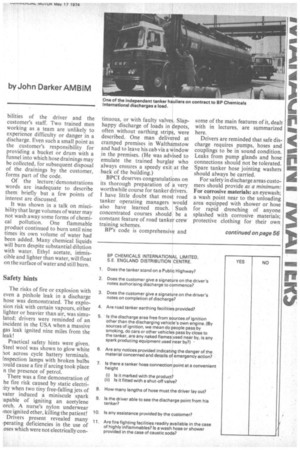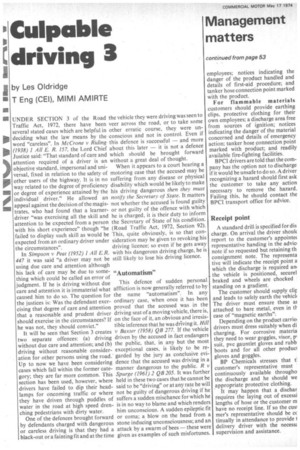Training tanker drivers to take the safe course
Page 54

Page 55

Page 58

If you've noticed an error in this article please click here to report it so we can fix it.
Chemical industry may soon require tangible proof of competence
CHEMICAL manufacturers are showing commendable zeal in taking their environmental responsibilities seriously. The larger companies in Britain would claim always to have done so; the relative infrequency of road accidents and incidents on customers' premises bears witness to the standards achieved.
Despite this, pressure from the Department of the Environment, from emergency services, and from the Chemical Industries Association, is bringing to light a number of unnecessary and unjustified risks in the movement by road of dangerous or hazardous goods.
The improvement of safety standards calls for effective co-operation between the chemical manufacturer (or distributor) his customer, and the transport operator involved. Independent tanker operators, who carry out so much work on contract to chemical manufacturers, have a specially onerous role to play as "middle men" responsible not only for their own drivers' proficiency but, in part, for the safe discharge of loads at the customer's premises.
Proof of competence
At a recent tanker drivers' safety training course I attended, it was stressed that the renewal of subcontractors' contracts would depend upon the rigorous maintenance of safety standards, and the use of approved types of discharging equipment. The chemical industry may soon require some tangible proof of the competence of all tanker drivers employed on hazardous load movements.
Mr Richard Beale, transport superintendent of BP Chemicals International, South East England operations, was largely responsible for arranging the safety training course, with the blessing of Mr K. F. Dawson, distribution manager for the area. The principal lecturer, a BPCI safety officer, was Mr Alan, Ness. His contrived explosions, using small samples of the chemicals produced by BPCI, and simple laboratory equipment, were enthralling to watch. During the one-day programme everyone attending was able to extinguish a simulated vehicle fire using dry-powder fire extinguishers.
Most of the drivers on the course were employed by independent road haulage companies working regularly for BP. The training provided was not intended to replace training by individual employers but rather to supplement this in a helpful way. The course was in line with recommendations in the CIA's booklet: "Road Transport of Hazardous Chemicals," specific objectives being: 0 To engender in the drivers a fundamental appreciation of safety.
O To impart the knowledge necessary to enable the drivers to handle flammable liquids safely.
O To familiarise the drivers with the company's off-site emergency procedure and in the use of Transport Emergency Cards.
O To advise the drivers of regulations relevant to the carriage by road of flammable materials.
In launching this type of course, which will be followed up by refresher courses periodically, BP began with the belief that some drivers are unduly complacent towards leaks and spillages of highly flammable liquids and there is some misunderstanding regarding tanker labelling.
It was expected that one byproduct would be a spate of reports from drivers about unsafe conditions and practices, primarily at discharging points. Drivers attending the course, at the Dagenham Docks premises of the Distillers Company, were told that reports of dangerous or questionable practices at customers' premises would be fully looked into but they must not expect instantaneous improvements.
Mr K. F. Dawson, who opened the course, stressed that there was a common interest in the safe delivery of BP's products which were all hazardous to some degree. The contribution the drivers could make was with the element of common sense. Customer firms often needed advice and guidance from tanker delivery drivers who could help BP greatly by reporting on less than ideal situations.
The meaning of terms like flammability (the British use of "inflammability" should surely be ended), toxicity, and corrosiveness were explained simply with a caution, by transport superintendent Richard Beale, that even chemists did not always understand the nature of all products made or distributed by P. In the course of a full day's lectures and demonstrations flash point, vapour density, flammable limits, ignition of mists, product miscibility with water, degreasing action of products, etc, were all fully explained.
I do not know how practicable it would be for all concerned with the road transport of hazardous chemicals to work to a recommended code of practice but there is obvious good sense in each manufacturing/distributing source devising a code relevant to the products handled.
The code
The BPCI code contains practical hints such as the use of PTFE tape to ease threading on stainless steel connectors. Drivers are advised on the responsibilities of the customer to set the valves on the receiving installation. It is the customer who must ensure that the receiving installation is in order and can take the quantity to be delivered. He must ensure that the tanker is connected to the correct inlet valve and that the inlet valve is open when the discharge is made.
A valuable feature of the BPCI code is that it spells out the responsi bilities of the driver and the customer's staff. Two trained men working as a team are unlikely to experience difficulty or danger in a discharge. Even such a small point as the customer's responsibility for providing a bucket or drum with a funnel into which hose drainings may be collected, for subsequent disposal of the drainings by the customer, forms part of the code.
Of the lecture,! demonstrations words are inadequate to describe them briefly but a few points of interest are discussed.
It was shown in a talk on miscibility that large volumes of water may not wash away some forms of chemical pollution. One flammable product continued to burn until nine times its own volume of water had been added. Many chemical liquids will burn despite substantial dilution with water. Ethyl acetate, immiscible and lighter than water, will float on the surface of water and still burn.
Safety hints
The risks of fire or explosion with even a pinhole leak in a discharge hose was demonstrated, The explosion risk with certain vapours, either lighter or heavier than air, was simulated; drivers were reminded of an incident in the USA when a massive gas leak ignited nine miles from the leak!
Practical safety hints were given. Steel wool was shown to glow white 'lot across cycle battery terminals. Inspection lamps with broken bulbs :.,ould cause a fire if arcing took place n the presence of petrol.
There was a fine demonstration of he fire risk caused by static electriity when two tiny free-falling jets of vater induced a miniscule spark :apable of igniting an acetylene orch. A nurse's nylon underwear ince ignited ether, killing the patient! Drivers present revealed many ,perating deficiencies in the use of oses which were not electrically con tinuous, or with faulty valves. Slaphappy discharge of loads in depots, often without earthing strips, were described. One man delivered at cramped premises in Walthamstow and had to leave his cab via a window in the premises. (I-le was advised to emulate the trained burglar who always ensures a speedy exit at the back of the building.) BPCI deserves congratulations on its thorough preparation of a very worthwhile course for tanker drivers. I have little doubt that most road tanker operating managers would also have learned much. Such concentrated courses should be a constant feature of road tanker crew' training schemes.
BP's code is comprehensive and some of the main features of it, dealt with in lectures, are summarized here.
Drivers are reminded that safe discharge requires pumps, hoses and couplings to be in sound condition. Leaks from pump glands and hose connections should not be tolerated. Spare tanker hose jointing washers should always be carried.
For safety in discharge areas customers should provide as a minimum. For corrosive materials: an eyewash; a wash point near to the unloading area equipped with shower or hose for rapid drenching of anyone splashed with corrosive materials; protective clothing for their own employees; notices indicating the danger of the product handled and details of first-aid procedure; and tanker hose connection point marked with the product.
For flammable materials customers should provide earthing clips, protective clothing for their own employees; a discharge area free from sources of ignition; notices indicating the danger of the material concerned and details of emergency action; tanker hose connection point marked with product; and readily available fire-fighting facilities.
BPCI drivers are told that the company has the option not to discharge if it would be unsafe to do so. A driver recognizing a hazard should first ask the customer to take any action necessary to remove the hazard. Failing this, he should contact the BPCI transport office for advice.
Receipt point
A standard drill is specified for dis charge. On arrival the driver shoulc report to the customer's appointee representative handing in the advio note if so requested but retaining th, consignment note. The representa tive will indicate the receipt point a which the discharge is required an, the vehicle is positioned, securel braked and wheels are chocked standing on a gradient.
The customer should supply clic and leads to safely earth the vehich The driver must ensure these al attached to bare metal, even in tlcase of "magnetic earths": Depending on the product carriel drivers must dress suitably when di charging. For corrosive materia they need to wear goggles, visor, p, suit, pvc gauntlet gloves and rubb boots and for all other produci gloves and goggles.
BP Chemicals stresses that tl customer's representative must continuously available througho the discharge and he should we appropriate protective clothing. It may happen that a dischar requires the laying out of excessi lengths of hose or the customer m have no receipt line. If so the cusi mer's representative should be cc tinually in attendance to provide delivery driver with the necessz supervision and assistance.








































































































